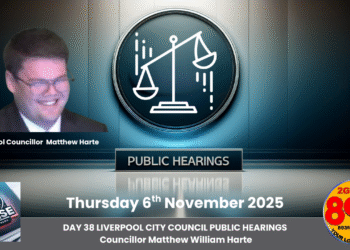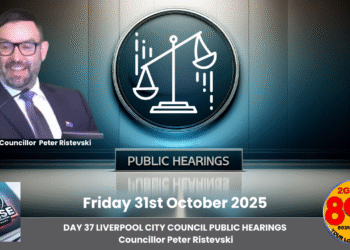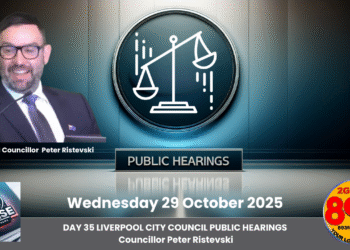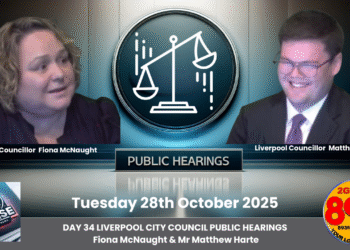Summary of Proceedings
Councillor Matthew Harte’s Testimony
- Procedural Update and Scheduling: The hearing began with Senior Counsel Assisting, Ms T McDonald SC, noting the receipt of additional documents relevant to Councillor Harte’s prior evidence. Due to the need for review and distribution via HighQ, Harte’s testimony on a new topic was to be completed that morning, with his evidence adjourned to Tuesday of the following week to allow parties to assess the new materials.
- Code of Conduct Complaints: Harte confirmed lodging 36 complaints as of 14 August 2025, with 35 targeting a specific councillor (identity discussed in private session). The inquiry referenced a spreadsheet of complaints provided by the council since October of the previous year. Harte had not reviewed the “Free Speech in Local Government in NSW” document recently introduced by the Office of Local Government (OLG), despite its relevance to complaint contexts.
- Specific Complaints and Private Session: Discussion of specific complaints, including one related to an ABC article on council cashflow issues and non-restricted cash reserves, moved to a private session at 10:27 AM due to concerns about maintaining the integrity of the complaint process and confidentiality, as raised by counsel for the council. The public session resumed at 2:03 PM with a different witness.
Vishwa Nadan’s Testimony
- Financial Overview for 2024/2025: Nadan, re-sworn as the CFO, provided updates on the council’s financial status. For the 2024/2025 financial year, an initial budget surplus of $2.6 million was anticipated in June 2024, but draft financial statements revealed a net operating deficit of $10.4 million before capital grants and contributions. These statements, audited with an expected unqualified opinion, are set to be presented at the next council meeting (late October 2025).
- Key Variations Causing Deficit: Nadan outlined factors driving the deficit in his August 2025 finance report:
- The failed sale of 3 Hoxton Park Road, impacting expected revenue.
- A $3.7 million shortfall in the Federal Government’s financial assistance grant advance payment (reduced from an expected 85% to 50%, with the remainder deferred to the next year).
- Provisions for termination payments and public inquiry expenses, impacting last year’s budget.
- A $1.4 million non-cash increase in council equity in Civic Risk Mutual, which reduced the deficit slightly by increasing income.
- Cash Reserves and Liquidity: As of 30 June 2025, the council held $416 million in cash and investments, with unrestricted reserves at $2.8 million, avoiding depletion. A delayed $7.3 million rights fee payment from Built Development (related to a land sale) was received in August 2025, boosting current year unrestricted reserves.
- Performance Indicators: Nadan reviewed financial ratios against OLG benchmarks, noting failures in operating performance ratio (indicating a deficit), debt service cover ratio (1.68 against a benchmark of 2), and rates/annual charges outstanding percentage (7.49% against 5%, though trending down). He highlighted liquidity concerns as critical for business performance, while noting the operating ratio’s challenges due to high depreciation ($57 million) and infrastructure growth.
- Infrastructure and Future Costs: Nadan emphasized the financial burden of new infrastructure (e.g., Woodward Park, Light Horse Park, Carnes Hill swimming pool) funded by $160 million in state grants, which incur ongoing operating costs not covered by grants or section 7.11 contributions. He suggested special rate variations as a potential solution to improve income, though the council currently lacks appetite for such measures.
- Long-Term Financial Plan for 2025/2026: The plan anticipates an $800,000 surplus, but a pessimistic scenario identifies risks, including a potential $5.1 million loss in a dispute with Canterbury-Bankstown Council over the Voyager Point pedestrian bridge. A settlement resulted in a $2.8 million payment for initial repairs, but a broader ownership transfer agreement was abandoned due to higher-than-expected repair costs.
Matters Arising of Interest to Ratepayers: Are Ratepayers Getting Good Value for Money?
Ratepayers of Liverpool City Council are concerned about whether their contributions result in effective financial management and governance. The following matters from Day 32 of the inquiry highlight areas where value for money is in question:
- Financial Management and Transparency:
- Significant Budget Deficit: The shift from a projected $2.6 million surplus to a $10.4 million deficit for 2024/2025, driven by failed asset sales, grant shortfalls, and unexpected provisions, raises serious concerns about financial planning accuracy. Ratepayers may question if their money is managed prudently when such large discrepancies occur, potentially affecting service delivery or future rate increases.
- Delayed Revenues and Liquidity Risks: While unrestricted reserves remain at $2.8 million, the delay in receiving $7.3 million from Built Development until August 2025 highlights timing issues that strain cashflow. Additionally, failing key OLG benchmarks (e.g., debt service cover, rates outstanding) signals liquidity challenges. Ratepayers may wonder if their contributions support a financially stable council capable of meeting obligations without emergency measures.
- Infrastructure Costs and Long-Term Burden:
- Operating Costs of New Infrastructure: Nadan’s testimony about $160 million in infrastructure projects (e.g., swimming pools, libraries) incurring ongoing operating costs (e.g., $2 million annually for a library) not covered by grants or contributions is alarming. Without special rate variations, which the council avoids, ratepayers may face increased burdens to sustain these assets, questioning whether current rates provide value when future costs loom.
- Missed Revenue Opportunities: The abandoned agreement with Canterbury-Bankstown Council over the Voyager Point bridge, costing a potential $5.1 million, and the failed Hoxton Park Road sale reflect lost revenue that could have eased financial pressures. Ratepayers may feel their money is not maximised when strategic opportunities are missed.
- Governance and Accountability:
- Code of Conduct Complaints: Councillor Harte’s 36 complaints, predominantly against one colleague, suggest internal conflict that diverts resources from community priorities. While details were discussed privately, the volume indicates potential dysfunction, costing ratepayer funds in processing and resolution. Ratepayers may question if their money supports a cohesive governing body or is wasted on disputes.
- Financial Oversight and Decision-Making: Nadan’s suggestion of special rate variations as a necessary review topic, despite council reluctance, highlights a disconnect between financial needs and political will. If infrastructure growth continues without revenue adjustments, ratepayers may not receive value as services could degrade or rates eventually spike without prior planning.
Conclusion
The Day 32 proceedings of the Public Inquiry into Liverpool City Council reveal critical challenges in financial management, infrastructure cost planning, and internal governance that impact whether ratepayers are receiving good value for their money. A substantial budget deficit, liquidity risks, and looming operating costs from new infrastructure suggest financial instability that could burden ratepayers further. Meanwhile, high volumes of code of conduct complaints indicate governance distractions that divert resources from community needs. Ratepayers deserve assurance that their contributions fund a financially sound and effectively managed council, yet evidence from this hearing underscores areas where value for money remains in doubt. As the inquiry progresses, these issues demand attention to ensure accountability and improvement at Liverpool City Council.



























